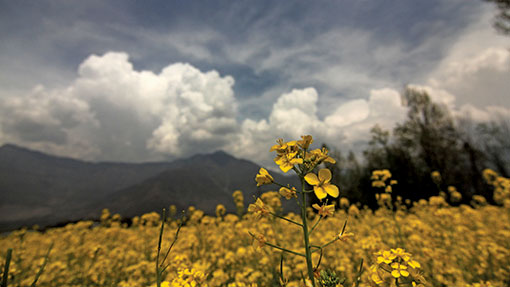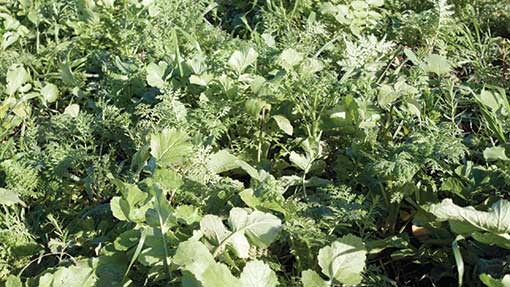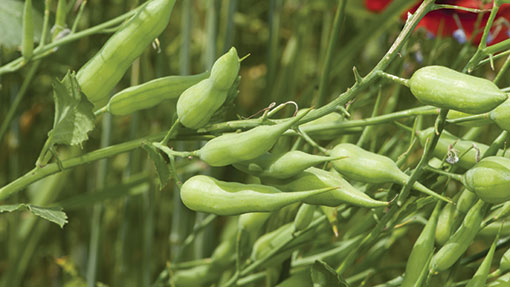Cover crops part of long-term approach to farm success

They deliver a range of soil and environmental benefits, fit well with spring cropping and have just received official greening recognition from Defra.
It’s not surprising then that cover crops are seen to have an important role in the future, with experts advising that they should be viewed as part of an integrated management strategy to help with various agronomic challenges.
That’s because cover crops protect or improve something, when they are used between cropping periods, explains Ron Stobart, head of agronomy, knowledge transfer and training at Niab Tag.
For this reason, they have plenty to offer, he says. “But they also have costs, so you must understand where they fit and their effect.”
Deciding what you want a cover crop to achieve is the first important step where they are being considered, he believes, as having too many objectives can be counter-productive.
“Improving the soil characteristics, either through deep or shallow rooting, is a common aim,” he says. “Or it may be that erosion management is needed, by getting ground cover to hold the soil in place, such as on a slope or an exposed site.”
Other reasons for cover crop use include preventing nutrient losses, with work showing that nitrate leaching can be halved by having the right cover in place, says Mr Stobart.
“Weed management by suppression is another motive, as is the use of a cover crop as a soil sterilant or biofumigant. Where the latter is the goal, the crop typically has to be chopped and cultivated into the soil surface after a period of growth, in order to release the chemicals that are produced.”
There are also fertility building benefits from certain cover crop mixes containing legumes, as well as soil organic matter enrichment from most cover crop choices, he adds.
Knowing what you are trying to do is important, as it will affect what you use as a cover crop, he explains.
Solution to cope with heavier farm machinery
Strixton, Northamptonshire
Helping soils to cope with ever heavier farm machinery was behind Northamptonshire grower David Hutchinson’s initial interest in cover crop mixes.
Having rescued a previously flooded field with a TerraLife mix, he was able to create a “fantastic” seed-bed for the following spring barley crop and became convinced of their role in improving soil health.
“We’ve always looked for ways to improve soil structure,” he says. “Soil underpins everything we do and if you don’t get the basics right you can waste a great deal of money on herbicides and fungicides without getting anything from them.”
Mr Hutchinson grows 80ha of spring barley within the environmental stewardship scheme on his 500ha farm at Strixton, near Wellingborough. Getting crop production to be more profitable and sustainable is high on his agenda, which is why the cover crop concept fits so well.
Better soil drainage and more organic matter are his twin aims. “Three things affect soil structure,” he says. “Organic matter, drainage and vehicle weight. If I can improve the first two of these, I’ve got more chance of the land standing up to the third – the vehicles.”
He used four of the TerraLife mixes, drilling them on 20 August in a field that had been flooded. “We were looking for instant soil structure improvement, so we mole drained under the standing crops in September and sprayed them off in October.”
Despite only being in the field for two months, the mix grew quickly and reached 350mm in height, he recalls. “The different levels of rooting were clear to see, with the deep-till radish being especially impressive. As a result, the following seed-bed was remarkable.”
He is now planning how to extend the use of cover crops. “It has to be the way forward. It uses photosynthesis to produce organic matter and help with drainage.”
He also predicts there will be more spring cropping in the future, both on his farm and others in the area. “Cover crop mixes create an opportunity to put organic matter back into the ground, rather than having it lying idle.”

“A single species, such as tillage radish or one of the brassicas, can be good at getting roots down deeply and quickly, so helping to improve soils at depth. Mixtures can also be used for this.
“But legume mixes are generally preferred for fertility-building requirements and will often contain three or four species.”
Using brassicas and legumes as cover crops has to be done with the existing rotation in mind, he warns. “If you already have these crops in your system, there’s a chance you could create higher volunteer, pest and disease pressure to manage. You don’t want to cause problems for the commercial crops.”
Of course, cover crops can be used in conjunction with HLS/ELS environmental schemes and are also part of the new CAP greening requirements. At the time of going to press, further information on greening rules was still awaited from Defra.
“We need the detail urgently, to understand how cover crops will fit and what their greening contribution is,” says Mr Stobart.
In terms of practicalities, how you sow a cover crop depends on what you are planting, he says. “With something like fodder radish, it’s usually a simple operation of raking the straw to even it up and create tilth, followed by broadcasting the seed and rolling it in.”
But on heavier soils, mustard has to be drilled for an even stand. “Look at the conditions and consider the size of the seed,” he recommends. “If it’s very dry, most cover crop choices will need drilling to put the seed into moisture.”

Including fodder radish (above) in a shallow-tillage approach can increase margins by about £50/ha.
Both legumes and brassicas can suffer from slug and flea beetle attack, he points out, leading to establishment problems. “They need to be treated as crops, to prevent disappointment.”
Nick Green of Kent-based T Denne & Sons says the establishment of cover crops is crucial to maximising their performance, especially with summer sown crops for autumn/winter cover.
“Establishment needs to be as close behind the previous crop as possible,” he advises. This is especially important with legumes, as they need to grow quickly while there is still warmth in the soil in order to fix more nitrogen. And if there are still longer sunlight hours, this will help, too.”
Mixtures without legumes could benefit from a low dose of nitrogen, of about 30kg/ha, he adds.
Establishment methods include auto-casting from the combine header, direct drilling and using a cultivator with a seeder unit, continues Mr Green.
“They all have pros and cons. Autocasting is quick and good where labour is limited, but direct drilling will produce a more even stand.”
Cover crop research
The New Farming Systems research project being undertaken at Morley, with support from the Morley Agricultural Foundation and the JC Mann Trust, has demonstrated improved soil characteristics and positive yield responses from the use of cover crops.
A range of cover crop approaches have been investigated, including a clover bi-crop, fodder radish and a legume mix. In addition, four cultivation approaches are being used in a long-term study, with and without the presence of a cover crop. The effect of three different nitrogen regimes is also being assessed.
Both the fodder radish and legume mix were sown at 10kg/ha in late August and were destroyed and incorporated ahead of drilling a spring crop. The clover bi-crop was also sown in August at the start of the project and has been allowed to regenerate naturally each season.
Improvements in water infiltration rates were recorded with the clover bi-crop approach, reports Mr Stobart, who adds that the magnitude of these would bring reductions in surface run-off and help to reduce soil erosion, nutrient loss and diffuse pollution risk.
“The yield response from the clover bi-crop was variable between years, which may have been due to seasonal factors that influenced nitrogen availability and uptake,” he points out.
“But there was a clear interaction between applied nitrogen dose in the wheat crop and the yield benefit delivered by the cover crop, in that the yield response fell as the nitrogen dose increased.”
However, the legume mix did give a consistent yield benefit, regardless of the nitrogen regime used, giving an increase in margin of about £60/ha.
Otherwise, the use of fodder radish gave good responses where it was used in a shallow tillage cultivation system, which was restricted to the top 10cm of soil. “In 2012, when the project was last in winter wheat, where fodder radish wasn’t used in the system, shallow tillage was the lowest-yielding and most variable treatment. With the inclusion of fodder radish it became the highest-yielding and least variable,” reports Mr Stobart.
Further examination suggests that including fodder radish in a shallow tillage approach can increase margins by about £50/ha, although this doesn’t take account of the establishment and management costs of the cover crop, he says.
In the study, the establishment cost for all cover crops was about £20/ha, with seed costs ranging from £30-50/ha, depending on the species and seed rates used.
“This suggests that cover crops cost the same to include as the financial benefit they provide,” says Mr Stobart. “However, their value to a farming system will vary, especially if they are part of an environmental scheme.”
Another key consideration is that cover crops are likely to take time to develop, with their frequency of use having a cumulative effect in the rotation, he adds.
Blackgrass control
Cover crops are being assessed for their contribution to blackgrass control at Agrovista’s Project Lamport, which is on a heavy land site in Northamptonshire.
The five-year project aims to reduce blackgrass populations while maintaining profitable crop production and is looking at the place for autumn-sown cover crops, used prior to sowing spring wheat.
With this specific grassweed control aim in mind, cover crop selection has to take account of various factors, explains Agrovista’s Mark Hemmant.
“On this heavy land site, the cover crop has to help with drying out soil at depth,” he says. “But it also has to leave a surface residue, so that some moisture is retained in the establishment zone.”
Soil structure benefits have to be provided too, he adds. “We need to be able to direct drill spring wheat afterwards, but we don’t want to create a seed-bed that blackgrass can take advantage of in the spring.”
There’s also a need to maximise the opportunity for out-of-crop control, he points out. “That means we don’t want too much cover too early, as we want the grassweeds to germinate. So an ability to sow a bit later gives us the chance to create a stale seed-bed before it is drilled.”
Other criteria are that the cover crop chosen must not reduce the performance of the spring wheat and should pose a low risk to the rest of the rotation. “It must be a take-all break and shouldn’t contain brassicas, so that oilseed rape crops aren’t affected.”
In addition, it must be easy to control if it occurs as a volunteer and to destroy in early spring, says Mr Hemmant.
The answer, he believes, is a black oat and vetch mix, which meets all of the above requirements and has given good results in the company’s trials.
“It did dry out the soil at depth and improve soil structure,” he reports. “There was also less soil disturbance at drilling and less blackgrass in the spring wheat.”
Indeed, when compared with an autumn fallow, there were just 4.3 blackgrass plants/sq m in the wheat crop after the Chlorofiltre mix had been used, but 15.3 plants/sq m after an autumn fallow.
Drilled at a rate of 25kg/ha at a depth of 1-2cm, the latest safe autumn sowing date of the mix is early to mid-September. The low seed rate of black oats in the mix allows the blackgrass to germinate throughout the autumn period and be controlled by glyphosate, but still produces enough biomass for soil benefits.
“For best results, you need a good seed-bed and you should roll after drilling to get good seed-to-soil contact.”
Slug pellets may be required, but nitrogen fertiliser isn’t. “The mix has good BYDV [barley yellow dwarf virus] resistance, but there may be a green bridge created, which will call for aphid control.”
The Chlorofiltre mix is destroyed with glyphosate in the early spring and a minimum two-week gap should be observed before planting the subsequent crop, he advises.
“We won’t know what effect, if any, it has had on the spring wheat yield until harvest,” says Mr Hemmant. “But we expect to see a lift in yield, due to lower blackgrass numbers and improved soil structure.”
What about brown mustard?
The biofumigant effects of brown mustard offer suppression of a range of soil pests, weeds and diseases, giving it a potential place in combinable and root crop rotations, says Ian Jackson of agronomy specialists ProCam.
As with all brassicas, brown mustard leaves contain glucosinolates, as well as an enzyme called myrosinase, which come together to produce isothiocyanates when the plant tissue is macerated and incorporated in the top 5cm of soil, he explains.
“This gas them permeates the soil and has a suppression or biofumigant effect.”
Drilled in either the spring or autumn, brown mustard takes 10-12 weeks to get to full height. It is chopped down by flailing or with double discs, before being worked into the soil. The field should then be rolled, to help contain the compound produced by the process.
The isothiocyanates are produced over a seven- to 12-day period and have been seen to have an effect on blackgrass, soil pests and fungi, such as take-all and sclerotinia.
“One of the other benefits of brown mustard is that it doesn’t seem to allow slugs to survive,” says Mr Jackson. “That can’t be said about all cover crops, some of which make slugs worse. Our work with white mustard, for example, has shown slug numbers increasing.”
In most situations, brown mustard is drilled immediately after harvest and then chopped down at the beginning of November, he reveals.
“It’s a very fine seed and is sown at a rate of about 5kg/ha, to establish about 300 plants/sq m,” he says. “It costs £22/acre.”
If required, a graminicide can be used to take out volunteer wheat, he advises. “There’s a competitive effect on blackgrass and a soil sterilant effect that kills weed seeds.”
As with other cover crops, there’s also a benefit from putting organic matter back into the soil. “You tend to get a better soil structure, which means residuals work better in the following crop.”
His colleague Paul Gardiner reports good results from brown mustard on blackgrass where it was drilled following failed oilseed rape on a heavy land farm. “Drilling date varied, from the spring right through to June,” he reports.
The crops were mulched in ahead of winter wheat being drilled. “Where it hadn’t been used, there was a carpet of black-grass. The results have been very visible and show the potential for such techniques.”
Scientific mixes give results
Complex cover crop mixes designed to root and work at different levels within the soil profile are used widely in Germany, says Dr Heino Schaupp of DSV in Dortmund.
Traditional green manure and cover crops have been used for many years, bringing limited benefits, but there’s now a very different approach available, he reports.
“Scientifically developed mixes, which may contain up to ten different species, are being used to meet agronomic objectives and improve the growth of following crops,” he explains.
Complementary species, some of which replace carbon content, others that break up compaction pans and others that fix nitrogen, work in harmony as soil conditioners – replacing the need for iron, diesel and chemistry in certain circumstances, he adds.
“The average farm size is much smaller in Germany,” he says. “And there are more mixed farms. So you could argue that there is more opportunity to grow cover crops.”
But there are also compelling reasons why the same approach is suitable for the UK, he believes. “There’s a need to build more resilience into crops and rotations, keeping soils open, healthy and fertile. A more variable climate, tighter rotations and bigger farm machinery are just a few of the reasons why there’s a need to change.”
The DSV concept is known as TerraLife and there are eight different mixes – including specific mixes for growing ahead of maize, potatoes and sugar beet.
“They contain rapidly growing plants that are sown after harvest and then cut back or desiccated before Christmas and left to decay back into the soil. The roots hold the soil together while the plants soak up nutrients – preventing leaching and erosion.”
Management objectives can be addressed with complex mixes, stresses Dr Schaupp. “It’s interesting to note that there can be a significant restoration of soil structure after just six to eight weeks.”
